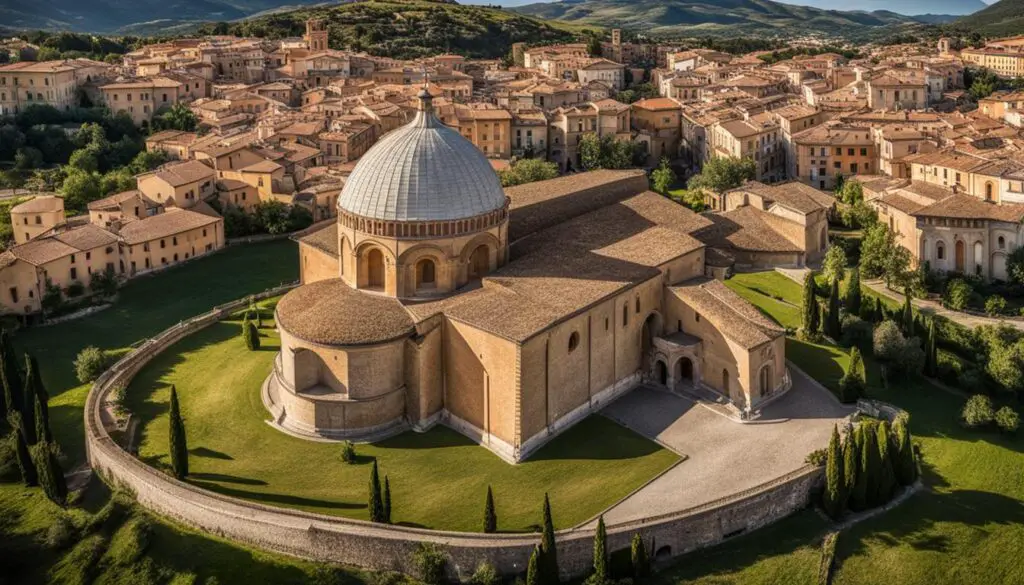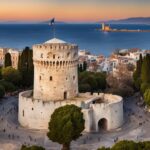Rome, the capital city of Italy, is a destination that attracts millions of visitors each year. Known for its rich history, stunning architecture, and iconic landmarks, Rome offers a plethora of attractions and sightseeing opportunities. From exploring ancient ruins to indulging in local cuisine, there is something for everyone in this vibrant city.
However, beyond the well-known tourist spots, Rome also hides a treasure trove of hidden gems waiting to be discovered. In this guide, we will take you off the beaten path and uncover the lesser-known attractions and neighborhoods that showcase the true essence of the Eternal City. Get ready to embark on a journey of exploration through the secret corners of Rome.
Key Takeaways:
- Explore Rome’s hidden gems for a unique and unforgettable experience.
- Venture off the beaten path to uncover Quartiere Coppedè’s fairy-tale architecture.
- Visit the Basilica di Santo Stefano Rotondo for its captivating frescoes and authentic atmosphere.
- Discover the charm of Trastevere, a neighborhood known for its local flair and traditional trattorias.
- Experience a panoramic view of Rome from Aventine Hill’s Knights of Malta Keyhole.
- Step into the opulence of ancient Rome at Domus Aurea, Nero’s Golden House.
- Take a journey back in time along the ancient Via Appia Antica and explore the Roman catacombs.
Quartiere Coppedè – A Fairy-tale Neighborhood
Quartiere Coppedè is a hidden gem in Rome that is often overlooked by tourists. Located in the northern part of the city, this fairy-tale neighborhood was designed by architect Gino Coppedè in the early 20th century. The district features a unique blend of architectural styles, including Greek, Art Nouveau, medieval, and Roman Baroque. With its enchanting buildings adorned with frescoes, mosaics, and intricate ironwork, Quartiere Coppedè is a must-visit for those seeking a taste of secret Rome.
In the heart of Quartiere Coppedè lies the Piazza Mincio, the focal point of the neighborhood. The square is surrounded by whimsical buildings, each telling its own story through elaborate decorations. The House of the Fairies, with its fairy tale-inspired motifs and ornate balconies, is a true architectural marvel that transports visitors to a magical world. The Fountain of Frogs, with its intricate stone frogs spouting water, adds to the enchantment of Quartiere Coppedè.
Exploring Quartiere Coppedè is like stepping into a storybook. As you wander through the narrow streets, you’ll discover hidden courtyards, hidden symbols, and hidden surprises around every corner. The neighborhood offers a peaceful and romantic atmosphere, away from the hustle and bustle of the main tourist areas. Whether you’re an architecture enthusiast or simply looking for a unique experience, Quartiere Coppedè is sure to captivate your imagination and leave you with lasting memories of your visit to Rome.
Quartiere Coppedè: A Blend of Architectural Styles
| Architectural Style | Characteristic Features |
|---|---|
| Greek | Columns, friezes, and pediments inspired by ancient Greek architecture |
| Art Nouveau | Curved lines, floral motifs, and decorative ironwork |
| Medieval | Towers, battlements, and arches reminiscent of medieval castles |
| Roman Baroque | Elaborate ornamentation, grand facades, and theatrical effects |
“Quartiere Coppedè is a hidden treasure in Rome, offering a glimpse into a world of architectural fantasies. The neighborhood’s whimsical design and unique blend of styles make it a must-see for anyone seeking a different side of the city.” – Architectural Digest
Quartiere Coppedè may be off the beaten path, but its charm and beauty are worth the detour. Take the time to explore this fairy-tale neighborhood and immerse yourself in the wonders of secret Rome.
Basilica di Santo Stefano Rotondo al Celio – A Circular Marvel
The Basilica di Santo Stefano Rotondo is a hidden gem among Rome’s many churches. Built in the 5th century, this circular church is the oldest example of its kind in the city. What sets it apart are the graphic frescoes depicting scenes of martyrdom that line the walls. The somber interior and authentic atmosphere make Santo Stefano Rotondo a truly unique and captivating place to visit. Despite its proximity to the Colosseum, this secret gem remains relatively unknown to many tourists.

The Basilica di Santo Stefano Rotondo holds great biblical importance. In biblical times, the circular shape of the church symbolized the heavenly kingdom and represented a gathering place for Christians. Notable biblical figures like Saint Stephen and Saint John the Baptist are associated with this sacred site.
In ancient times, the Basilica di Santo Stefano Rotondo served as a place of worship and a burial ground for early Christian martyrs. The walls adorned with frescoes depicting their martyrdom serve as a powerful reminder of the sacrifices made for the Christian faith. The circular layout of the church allowed for a unique communal experience, emphasizing the unity of the Christian community.
Key Features of Basilica di Santo Stefano Rotondo:
- Oldest circular church in Rome
- Graphic frescoes depicting scenes of martyrdom
- Biblical significance and association with notable figures
- Somber interior and authentic atmosphere
Today, the Basilica di Santo Stefano Rotondo continues to be a place of worship and a site of historical and cultural significance. Visitors can admire the intricate frescoes and immerse themselves in the rich history of this hidden church. Its serene atmosphere provides a peaceful escape from the bustling streets of Rome, allowing individuals to connect with the past and appreciate the enduring beauty of this circular marvel.
Trastevere – Charming District with Local Flair
Trastevere is a hidden gem nestled across the Tiber River from Rome’s city center. Known for its narrow cobblestone streets and traditional trattorias, this neighborhood offers a charming and authentic atmosphere that is often missed by tourists. While the main square, Piazza di Santa Maria, attracts its fair share of visitors, there are hidden corners of Trastevere waiting to be explored.
One of the best ways to experience the local flair of Trastevere is through its food scene. The neighborhood is home to numerous local restaurants where you can savor authentic Roman dishes. From classic pasta dishes like carbonara and cacio e pepe to mouthwatering pizzas and Roman-style street food like supplì, Trastevere offers a culinary journey that is sure to delight your taste buds.
As you venture further into Trastevere, be sure to explore the outdoor food market on Piazza di San Cosimato. Here, you can find fresh produce, regional cheeses, local wines, and an array of delightful snacks. Take your time to wander the market, interact with the friendly vendors, and immerse yourself in the vibrant atmosphere of this lesser-known part of Rome.
Trastevere is also known for its picturesque streets and vibrant nightlife. As you wander through its narrow alleys, you’ll come across colorful buildings adorned with flower boxes, hidden courtyards, and charming artisan shops. The best way to experience Trastevere’s vibrant nightlife is by visiting one of its many bars or wine bars. Sip on a glass of local wine, listen to live music, and soak in the energetic ambiance of this lively district.
Hidden Treasures in Trastevere:
- The Basilica of Santa Cecilia: Visit this beautiful church dedicated to the patron saint of music, where you can admire stunning frescoes and a crypt dating back to ancient Rome.
- Villa Farnesina: Explore this Renaissance villa, famous for its stunning frescoes by Raphael and other renowned artists.
- Orto Botanico: Take a leisurely stroll through this peaceful botanical garden, home to a vast collection of plants and trees from around the world.
In conclusion, Trastevere is a hidden neighborhood in Rome that offers a delightful mix of local charm, culinary delights, and hidden treasures. Take the time to venture off the beaten path and explore this vibrant district to truly experience the authentic side of Rome. From its picturesque streets to its lively nightlife, Trastevere is sure to leave you with unforgettable memories of your time in the Eternal City.
Aventine Hill and Knights of Malta Keyhole – A View like No Other
Perched atop the Aventine Hill, one of Rome’s seven hills, lies a secret viewpoint that offers a view like no other in the city. Known as the Knights of Malta Keyhole, this unassuming door leads to an extraordinary vantage point that frames a breathtaking panorama of Rome.

Stepping through the keyhole, visitors are treated to a captivating sight: the perfectly framed dome of St. Peter’s Basilica in Vatican City, beautifully contrasted against the backdrop of Rome’s historic rooftops and monuments. The Knights of Malta Keyhole provides a unique perspective that showcases the grandeur and beauty of the Eternal City in a way few tourists have the privilege to experience.
Legend has it that the precise alignment of the keyhole with the dome of St. Peter’s Basilica was deliberate, offering a symbolic glimpse into the heart of the Vatican. This hidden gem provides an enchanting blend of history, architectural marvel, and natural beauty, making it a must-visit for those seeking a truly extraordinary view of Rome.
Biblical Significance and Historical Context
Aventine Hill holds biblical importance as it is believed to be the location of the house of the biblical figure of Remus, one of the legendary founders of Rome. According to Roman mythology, Remus and his twin brother Romulus were abandoned as infants and raised by a she-wolf on the Palatine Hill. Their eventual dispute over who would be the ruler of the new city led to Romulus killing Remus and becoming the first king of Rome.
In biblical times, Aventine Hill was a wealthy residential area, inhabited by influential families and aristocrats. It was known for its magnificent gardens, luxurious villas, and stunning views of the Tiber River. The hill played a significant role in shaping the history and development of ancient Rome, witnessing both glory and tumultuous times.
Today, Aventine Hill and the Knights of Malta Keyhole continue to captivate visitors with their beauty and historical significance. The view from this secret viewpoint remains an awe-inspiring testament to the rich heritage and architectural wonders that define the Eternal City.
Domus Aurea – Nero’s Golden House

The Domus Aurea, also known as Nero’s Golden House, is one of Rome’s most extravagant constructions. Built by Emperor Nero in the 1st century, this palace complex covered a vast area and was lavishly decorated with frescoes, mosaics, and semi-precious stones. Today, you can explore the underground ruins of the Domus Aurea and learn about its fascinating history. This hidden gem provides a glimpse into the opulence of ancient Rome and the legacy of its notorious emperor.
“I found Rome a city of bricks and left it a city of marble.” – Emperor Augustus
The Domus Aurea was a symbol of Nero’s power and grandeur. It consisted of landscaped gardens, an artificial lake, and even a rotating dining room. The interior was adorned with intricate frescoes and mosaics that depicted scenes from mythology and everyday life. The palace also featured innovative architectural elements, such as vaulted ceilings and domed rooms.
Despite being destroyed and buried for centuries, the Domus Aurea has been partially excavated and opened to the public. Visitors can explore the underground passages and chambers, marvel at the remnants of its once-grand architecture, and imagine the splendor of Nero’s Golden House in its heyday.
The Biblical Importance of Nero’s Palace
While the Domus Aurea is not directly mentioned in the Bible, it played a significant role in shaping the history of ancient Rome. Nero, the emperor associated with the palace, is mentioned in the New Testament in the context of the early Christian persecution. The notorious Great Fire of Rome in 64 AD, which Nero blamed on the Christians, led to widespread persecution and martyrdom.
The opulence and extravagance of the Domus Aurea stood in stark contrast to the humble beginnings of Christianity. The early Christians faced persecution and oppression under Nero’s rule, and the grandeur of his palace served as a reminder of the stark social and economic disparities of the time. Despite the persecution, Christianity continued to spread and flourish, eventually becoming the dominant religion of the Roman Empire.
Today, the Domus Aurea stands as a testament to the excesses of ancient Rome and the enduring legacy of one of its most infamous emperors. It serves as a reminder of the rise and fall of empires and the resilience of human history.
| Domus Aurea – Nero’s Golden House | Biblical Significance |
|---|---|
| Extravagant palace complex built by Emperor Nero in the 1st century | Associated with the early Christian persecution under Nero’s rule |
| Lavishly decorated with frescoes, mosaics, and semi-precious stones | Symbolized the stark social and economic disparities of ancient Rome |
| Partially excavated and open to the public | Reminds us of the rise and fall of empires and the endurance of human history |
Via Appia Antica – Step Back in Time
Via Appia Antica, also known as the Appian Way, holds immense biblical importance and is one of Rome’s oldest and most historically significant roads. Mentioned in the Bible, this ancient road was a vital part of Rome’s infrastructure and played a significant role in connecting the city to its empire. It served as a strategic route for military movements and facilitated trade and commerce.
In biblical times, prominent figures like the Apostle Paul walked along the Via Appia Antica on their journeys. It was on this road that Paul met Roman Christians who greeted him as he approached Rome, providing a significant moment in the history of the early Christian church. The road’s historical significance and biblical associations make it a remarkable place to explore for those interested in the intersection of ancient Rome and biblical events.
The Appian Way was lined with catacombs, which were underground burial sites where early Christians buried their dead. These catacombs hold great historical and religious significance, as they served as a place of remembrance and commemoration for the early Christian community. Today, visitors can explore the catacombs and gain insight into the religious practices and beliefs of early Christians in Rome.
Walking along the ancient cobblestones of Via Appia Antica provides a unique opportunity to step back in time and experience the rich history of ancient Rome. Whether you’re interested in biblical history, ancient roads, or the Roman catacombs, this hidden gem offers a glimpse into the past and a chance to connect with the historical and spiritual roots of Rome.
Giardino degli Aranci – A Garden with a View
The Giardino degli Aranci, also known as Parco Savello, is a hidden gem nestled atop the Aventine Hill in Rome. This symmetrical garden offers a tranquil escape from the bustling city streets while providing breathtaking views of Rome’s iconic landmarks. With its fragrant orange blossoms and lush greenery, the Giardino degli Aranci is the perfect spot to relax and soak in the panoramic scenery.
As you stroll through the garden, you’ll encounter rows of neatly trimmed orange trees, creating a vibrant and picturesque setting. Take a seat on one of the benches strategically placed throughout the park and marvel at the iconic dome of St. Peter’s Basilica, which stands prominently in the distance. The Tiber River winds its way through the landscape, adding to the enchanting atmosphere of the garden.
“A visit to the Giardino degli Aranci is a true feast for the senses. The fragrance of the orange blossoms, the gentle rustling of leaves, and the stunning views create a serene and magical experience.”
Hidden Parks in Rome
The Giardino degli Aranci is part of a network of hidden parks in Rome, offering a peaceful retreat for both locals and visitors alike. These parks, tucked away in various corners of the city, provide an opportunity to escape the crowds and discover a different side of Rome. From the romantic gardens of Villa Borghese to the lush greenery of Villa Doria Pamphilj, each hidden park offers its own unique charm and a chance to connect with nature.
Whether you’re looking to enjoy a picnic, take a leisurely stroll, or simply find solace in the beauty of nature, Rome’s hidden parks provide a serene oasis in the heart of the bustling city. Embrace the tranquility, unwind, and admire the captivating views that these hidden gems have to offer.

| Park | Location | Key Features |
|---|---|---|
| Villa Borghese | City Center | Romantic gardens, boating lake, art gallery |
| Villa Ada | North Rome | Lake, woodland trails, outdoor concerts |
| Villa Pamphilj | West Rome | Largest landscaped park, jogging trails, picnic areas |
| Villa Torlonia | North Rome | Historic gardens, neoclassical buildings, museum |
Vicus Caprarius – Underground Wonders
Vicus Caprarius is a hidden gem tucked away beneath the bustling Trevi district in Rome. This ancient underground complex offers a fascinating glimpse into the city’s history and showcases the remarkable engineering feats of the past. Stretching 30 feet below street level, Vicus Caprarius reveals the ancient Vergine aqueduct, which still supplies water to the iconic Trevi Fountain. Exploring this subterranean marvel is like stepping back in time and immersing yourself in the secrets of ancient Rome.

In biblical times, Vicus Caprarius played a significant role in the lives of the people of Rome. The aqueduct system, including the one connected to Vicus Caprarius, provided vital water sources for the city’s inhabitants, ensuring their survival and enabling the growth of the empire. The aqueducts were an engineering marvel and a testament to the advanced technology of the time.
While Vicus Caprarius itself doesn’t have direct biblical significance, it is a testament to the historical and cultural importance of water in ancient Rome. Water played a crucial role in daily life, from providing for basic needs to enabling the extravagant fountains and baths that adorned the city. Understanding the aqueduct system, including Vicus Caprarius, helps us appreciate the ingenuity and infrastructure of the ancient world.
Key Features of Vicus Caprarius:
- An underground complex showcasing the ancient Vergine aqueduct
- Archaeological treasures that tell the story of ancient Rome
- Impressive engineering feats of the aqueduct system
- Connection to the iconic Trevi Fountain and its water supply
Today, Vicus Caprarius offers visitors a unique and immersive experience. Explore the underground pools, marvel at the ancient architecture, and learn about the history of Rome’s water supply. The site provides a fascinating insight into the daily life of ancient Romans and the achievements of their civilization. Vicus Caprarius is a hidden attraction that enriches our understanding of Rome’s past and allows us to appreciate the legacy left behind by our ancestors.
Conclusion
Rome is a city that never ceases to amaze with its rich history, stunning architecture, and hidden treasures. By venturing off the beaten path, you can discover a side of Rome that many tourists miss. From Quartiere Coppedè’s fairy-tale architecture to the panoramic views from Giardino degli Aranci, each hidden gem provides a unique and unforgettable experience.
Whether you’re interested in ancient history, local culture, or simply seeking a different perspective of the city, Rome’s hidden gems have something for everyone. These off-the-beaten-path sights showcase the lesser-known aspects of Rome’s historical and cultural heritage, offering a deeper understanding of the Eternal City.
Step back in time with a visit to the ancient ruins of the Domus Aurea or explore the underground wonders of Vicus Caprarius. Stroll through the charming streets of Trastevere or wander along the Appian Way, one of Rome’s oldest roads. Each hidden gem holds a piece of history and a story waiting to be discovered.
So, when planning your Rome travel guide, don’t forget to include these hidden gems in your itinerary. Immerse yourself in the beauty and secrets of Rome, and create memories that will last a lifetime. Explore off the beaten path and uncover the hidden treasures that make Rome truly extraordinary.
FAQ
Are these hidden gems easily accessible for tourists?
Yes, all of the hidden gems mentioned in this guide are accessible to tourists. Some may require a short walk or detour from the main tourist areas, but they are well worth the visit.
Are these hidden gems crowded with tourists?
No, these hidden gems are not as crowded as the main tourist attractions in Rome. While they may still have some visitors, they offer a quieter and more intimate experience compared to the crowded tourist areas.
Are guided tours available for these hidden gems?
Yes, there are guided tours available for some of these hidden gems. You can check with local tour operators or do some research online to find guided tours that cater to your interests.
Can I visit these hidden gems on my own or do I need a guide?
You can visit these hidden gems on your own without a guide. However, having a guide can enhance your experience by providing you with historical and cultural insights.
Are these hidden gems suitable for families with children?
Yes, these hidden gems are suitable for families with children. They offer a unique and educational experience that can be enjoyed by people of all ages.
Are there any entry fees for these hidden gems?
Some of these hidden gems may have entry fees, while others are free to visit. It’s best to check the specific details of each attraction before visiting.
Can I take photos at these hidden gems?
Yes, you can take photos at these hidden gems. However, it’s always a good idea to be respectful of the surroundings and other visitors while taking photos.







